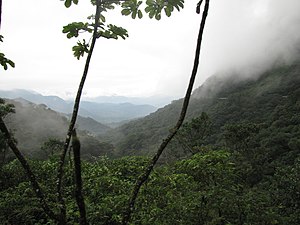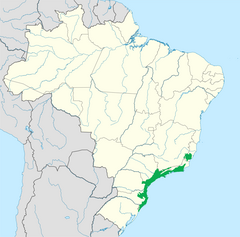Serra do Mar coastal forests

Multi tool use
| Serra do Mar coastal forests | |
|---|---|
 Forest in Serra do Mar, Paraná, Brazil. | |
 Serra do Mar coastal forests localization as delineated by WWF. | |
| Ecology | |
| Biome | Atlantic Forest |
| Borders |
|
| Bird species | 628[1] |
| Mammal species | 175[1] |
| Geography | |
| Area | 104,800 km2 (40,500 sq mi) |
| Country | |
| States | São Paulo, Rio de Janeiro, Paraná, Minas Gerais, Espírito Santo, Santa Catarina and Rio Grande do Sul |
| Conservation | |
| Habitat loss | 70.0%[2] |
| Protected | 51.0%[3] |
The Serra do Mar coastal forests is an ecoregion of the tropical moist forests biome, and of the South American Atlantic Forest biome.
Contents
1 Geography
2 Natural history
3 Conservation
4 See also
5 References
6 External links
Geography
The Serra do Mar mountain range defines this ecoregion. The Serra do Mar coastal forests are located in the Serra do Mar, along the southern coast of Brazil for about 1,000 kilometres (620 mi).
The ecoregion lies within the states of São Paulo, Rio de Janeiro, Paraná, Minas Gerais, Espírito Santo, Santa Catarina, and Rio Grande do Sul.
Natural history
The climate is subtropical with high levels of annual rainfall.
The montane tropical moist forest habitats are vegetated with species of Bromeliaceae, Myrtaceae, Melastomataceae and Lauraceae. This region has an outstanding biodiversity consisting of flora, mammals, birds, and herpetofauna.
Conservation
70% of the original forest has already been altered by settlement and agriculture. 51% is currently in protected areas.
The primary ongoing threats to this ecoregion are urban development and tourism infrastructure.

Satellite picture of Serra do Mar coastal forests ecoregion (within yellow line).
The deforestation (tan areas) of the ecoregion is visible.

Golden lion tamarin, an endemic species of the Serra do Mar coastal forests, in Rio de Janeiro.
- Specifications
Biome: Tropical and subtropical moist broadleaf forests
Realm: Neotropical
WWF ID: NT0160
Size: 104,800 square kilometers
See also
List of plants of Atlantic Forest vegetation of Brazil — flora of its diverse ecoregions.- Ecoregions in the Atlantic Forest biome
- List of ecoregions in Brazil
References
^ ab
Hoekstra, J. M.; Molnar, J. L.; Jennings, M.; Revenga, C.; Spalding, M. D.; Boucher, T. M.; Robertson, J. C.; Heibel, T. J.; Ellison, K. (2010). Molnar, J. L., ed. The Atlas of Global Conservation: Changes, Challenges, and Opportunities to Make a Difference. University of California Press. ISBN 978-0-520-26256-0..mw-parser-output cite.citation{font-style:inherit}.mw-parser-output q{quotes:"""""""'""'"}.mw-parser-output code.cs1-code{color:inherit;background:inherit;border:inherit;padding:inherit}.mw-parser-output .cs1-lock-free a{background:url("//upload.wikimedia.org/wikipedia/commons/thumb/6/65/Lock-green.svg/9px-Lock-green.svg.png")no-repeat;background-position:right .1em center}.mw-parser-output .cs1-lock-limited a,.mw-parser-output .cs1-lock-registration a{background:url("//upload.wikimedia.org/wikipedia/commons/thumb/d/d6/Lock-gray-alt-2.svg/9px-Lock-gray-alt-2.svg.png")no-repeat;background-position:right .1em center}.mw-parser-output .cs1-lock-subscription a{background:url("//upload.wikimedia.org/wikipedia/commons/thumb/a/aa/Lock-red-alt-2.svg/9px-Lock-red-alt-2.svg.png")no-repeat;background-position:right .1em center}.mw-parser-output .cs1-subscription,.mw-parser-output .cs1-registration{color:#555}.mw-parser-output .cs1-subscription span,.mw-parser-output .cs1-registration span{border-bottom:1px dotted;cursor:help}.mw-parser-output .cs1-hidden-error{display:none;font-size:100%}.mw-parser-output .cs1-visible-error{font-size:100%}.mw-parser-output .cs1-subscription,.mw-parser-output .cs1-registration,.mw-parser-output .cs1-format{font-size:95%}.mw-parser-output .cs1-kern-left,.mw-parser-output .cs1-kern-wl-left{padding-left:0.2em}.mw-parser-output .cs1-kern-right,.mw-parser-output .cs1-kern-wl-right{padding-right:0.2em}
^ Ribeiro, M. C.; Metzger, Jean Paul; et al. (2009). "The Brazilian Atlantic Forest: How much is left, and how is the remaining forest distributed? Implications for conservation". Biological Conservation. 142 (6): 1141–1153. doi:10.1016/j.biocon.2009.02.021.CS1 maint: Explicit use of et al. (link)
^ "Visão da Biodiversidade da Ecorregião da Serra do Mar" (PDF).
.mw-parser-output .refbegin{font-size:90%;margin-bottom:0.5em}.mw-parser-output .refbegin-hanging-indents>ul{list-style-type:none;margin-left:0}.mw-parser-output .refbegin-hanging-indents>ul>li,.mw-parser-output .refbegin-hanging-indents>dl>dd{margin-left:0;padding-left:3.2em;text-indent:-3.2em;list-style:none}.mw-parser-output .refbegin-100{font-size:100%}
"Serra do Mar coastal forests". Terrestrial Ecoregions. World Wildlife Fund.
External links
| Wikimedia Commons has media related to Serra do Mar. |
FB7tdp1G7,ICCEL0IO,VQLgdelTQHAs,BID,S7MiHYbST